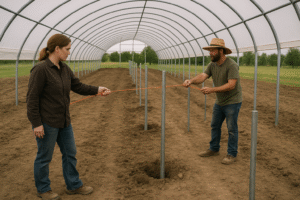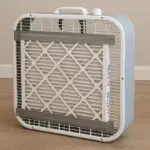Extending Our High Tunnels: Building Greenhouses That Last Decades
Extending Our High Tunnels: Building Greenhouses That Last Decades
Building Bigger and Better High Tunnels
What started as a few modest high tunnels has turned into a full-scale greenhouse expansion project. With a little grit, a vintage concrete mixer, and a lot of teamwork, we’re extending our tunnels by 24 more feet—adding space for hundreds more tomato plants and ensuring these structures last for decades.
This post dives into how we’re reinforcing our tunnels with tens of thousands of pounds of concrete, reusing good parts, and making sure the soil and alignment are perfect for long-term performance.
TL;DR
-
We extended our high tunnels by 24 feet, creating over 800 extra square feet for growing.
-
Used 30,000+ pounds of concrete so far—nearly 6 pallets of 80-lb bags.
-
Our rich river-bottom soil is ideal: over six feet deep before any clay or rock.
-
We salvaged and reused every good part possible, minimizing waste.
-
Our 1970s concrete mixer—refurbished with a new switch—has been a lifesaver.
From Extra Parts to Extra Tomatoes
When we first bought our greenhouses, they were shorter structures surrounded by scattered parts. Instead of letting those pieces rust away in the field, we inventoried what was usable and found enough strong steel sections to extend each tunnel by 12 more feet.
With two tunnels extended, we’ve now got a total footprint of 24 by 35 feet per structure—room for more rows of healthy tomato plants and improved airflow. Every usable piece got a second life, while bent or poorly welded parts were swapped out.

The Foundation: Concrete and Commitment
So far, we’ve mixed and poured over 30,000 pounds of concrete—and we’re not done yet. That’s six full pallets, or roughly 384 bags. By the end, we’ll have put around 100,000 pounds of concrete into the ground to secure these structures against wind, snow, and time itself.
Instead of using a modern rental mixer, we brought out a vintage 1970s concrete mixer—a solid piece of engineering that we’ve modified with our own external switch for convenience and safety. It’s been saving us hours per day compared to mixing by hand, proving once again that older tools can still deliver when maintained right.
Soil So Good, It’s Almost Unfair
We can’t talk about building tunnels without talking about the soil beneath them. Our site sits just beside a river, where years of sediment have created an incredibly fertile loam layer. We’ve drilled hundreds of holes for posts and hit rock only once—a rare gift in any construction project.
This six-foot-deep topsoil helps with drainage, stability, and root development, which means healthier plants and sturdier foundations. With soil this consistent, we can drive supports deep and trust the base will hold for years.

Precision and Teamwork in Every Post
Every hole, pole, and beam gets placed with precision. Using layout tape across the full span of each tunnel, we measure and re-measure to keep spacing uniform. That attention to detail makes the structures stronger and the workflow smoother once plants go in.
The team includes everyone from experienced builders to young helpers—like Lauren, who’s just 17 but already a pro with ladders, drills, and greenhouse construction. As we like to say: why build in Fortnite when you can build for real?
What’s Next for the Tomato Greenhouses
With the extensions finished, we’re adding trellising systems that rise all the way to the new crossbeams. One of our main tunnels now measures a full 96 feet long by 35 feet wide, giving us a flexible and resilient growing space that should last 20+ years with proper care.
These long-term projects are about more than just crops—they’re investments in sustainability, learning, and the satisfaction of creating something built to last.
Key Takeaway
By combining reused materials, durable concrete foundations, vintage equipment, and fertile soil, we’re building high tunnels that will support healthy harvests for decades. Strong structures mean stronger plants—and a more sustainable way to grow.

